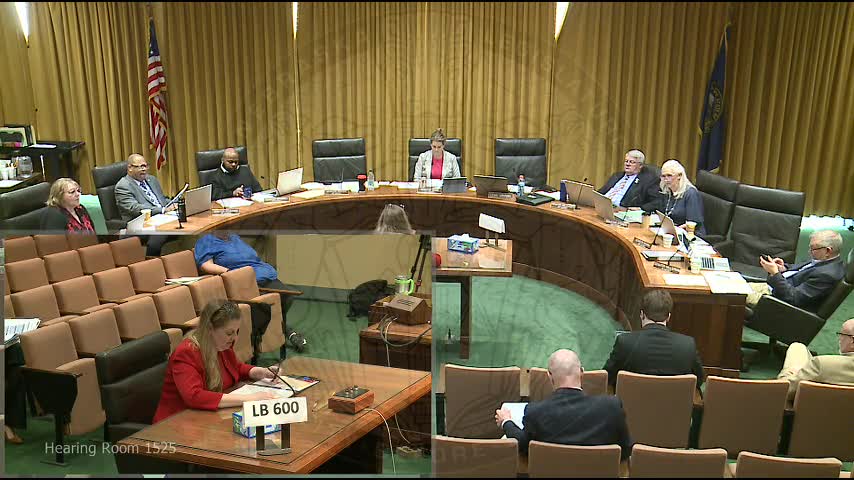NDOT-backed LB600 would allow work‑zone speed cameras, variable speed limits and expanded move‑over authority
March 29, 2025 | 2025 Legislature NE, Nebraska
This article was created by AI summarizing key points discussed. AI makes mistakes, so for full details and context, please refer to the video of the full meeting. Please report any errors so we can fix them. Report an error »

Senator Wendy DeBoer introduced LB600, a Department of Transportation‑backed highway‑safety package that would authorize speed‑control enforcement systems in temporary work zones and allow NDOT to use variable speed limits under specified hazardous conditions.
DeBoer described the bill as “ensuring our roadways are safe for those traveling and for those working on our roads,” and detailed four elements: temporary speed cameras for work zones, permanent cameras for school crossing zones tied to warning lights, NDOT authority to remove roadway debris in emergencies, and a variable speed limit authority limited to downward adjustments when weather or road conditions reduce safety.
Vikki Kramer, director of the Nebraska Department of Transportation, testified in support and cited national statistics. Kramer said, “Driving is the most dangerous activity your constituents will do on an average day,” and that data show speed cameras and variable limits can reduce fatal and injury crashes. Kramer and NDOT proposed guardrails in the bill, including signed notifications, a warning for the first violation and administrative civil penalties for subsequent violations. A Department attorney said the proposal is modeled on programs in other states and emphasized the bill’s consumer‑privacy guardrails and the limited scope of enforcement to work or school zones.
Proponents from contractors, highway engineers and AAA testified that cameras and variable limits are proven countermeasures for work‑zone and intersection safety. Opponents, including the ACLU and county law enforcement, raised due‑process and vendor‑data retention concerns similar to testimony in the red‑light bill hearings. Kearney Police Chief Bryan Waugh and the Nebraska Sheriffs Association urged caution about data sharing and the risk of diminishing law‑enforcement access to ALPR systems used in criminal investigations.
Key technical clarifications from the hearing: NDOT’s proposal used an 11‑mph‑over threshold for camera enforcement in work zones and a 6‑mph‑over threshold in school crossing zones when the warning lights are active; the first camera‑detected infraction would be a warning, with civil penalties for repeat violations. Kramer said the policy is intended to change driver behavior rather than raise revenue.
Next steps: Committee members asked about data retention, vendor contracts, and whether NDOT or law enforcement would administer enforcement and notices. No committee vote was taken; the department and stakeholders indicated willingness to refine contract and privacy protections.
DeBoer described the bill as “ensuring our roadways are safe for those traveling and for those working on our roads,” and detailed four elements: temporary speed cameras for work zones, permanent cameras for school crossing zones tied to warning lights, NDOT authority to remove roadway debris in emergencies, and a variable speed limit authority limited to downward adjustments when weather or road conditions reduce safety.
Vikki Kramer, director of the Nebraska Department of Transportation, testified in support and cited national statistics. Kramer said, “Driving is the most dangerous activity your constituents will do on an average day,” and that data show speed cameras and variable limits can reduce fatal and injury crashes. Kramer and NDOT proposed guardrails in the bill, including signed notifications, a warning for the first violation and administrative civil penalties for subsequent violations. A Department attorney said the proposal is modeled on programs in other states and emphasized the bill’s consumer‑privacy guardrails and the limited scope of enforcement to work or school zones.
Proponents from contractors, highway engineers and AAA testified that cameras and variable limits are proven countermeasures for work‑zone and intersection safety. Opponents, including the ACLU and county law enforcement, raised due‑process and vendor‑data retention concerns similar to testimony in the red‑light bill hearings. Kearney Police Chief Bryan Waugh and the Nebraska Sheriffs Association urged caution about data sharing and the risk of diminishing law‑enforcement access to ALPR systems used in criminal investigations.
Key technical clarifications from the hearing: NDOT’s proposal used an 11‑mph‑over threshold for camera enforcement in work zones and a 6‑mph‑over threshold in school crossing zones when the warning lights are active; the first camera‑detected infraction would be a warning, with civil penalties for repeat violations. Kramer said the policy is intended to change driver behavior rather than raise revenue.
Next steps: Committee members asked about data retention, vendor contracts, and whether NDOT or law enforcement would administer enforcement and notices. No committee vote was taken; the department and stakeholders indicated willingness to refine contract and privacy protections.
View full meeting
This article is based on a recent meeting—watch the full video and explore the complete transcript for deeper insights into the discussion.
View full meeting
